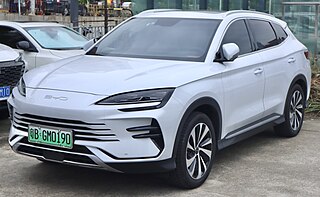
A hybrid vehicle is one that uses two or more distinct types of power, such as submarines that use diesel when surfaced and batteries when submerged. Other means to store energy include pressurized fluid in hydraulic hybrids.

The Honda Insight is a hybrid electric vehicle that is manufactured and marketed by Honda. Its first generation was a two-door, two passenger liftback (1999–2006) and in its second generation was a four-door, five passenger liftback (2009–2014). In its third generation, it became a four-door sedan (2018–2022). It was Honda's first model with Integrated Motor Assist system and the most fuel efficient gasoline-powered car available in the U.S. without plug-in capability for the length of its production run.

A diesel–electric transmission, or diesel–electric powertrain, is a transmission system for vehicles powered by diesel engines in road, rail, and marine transport. Diesel–electric transmission is based on petrol–electric transmission, a transmission system used for petrol engines.

The Ford Fusion Hybrid is a gasoline-electric hybrid powered version of the mid-sized Ford Fusion sedan manufactured and marketed by Ford, which had two generations. A plug-in hybrid version, the Ford Fusion Energi, was released in the U.S. in February 2013. The last model year for all Ford Fusions was 2020.

The Ford C-Max is a car produced by the Ford Motor Company from 2003 to 2019. It has a five-door compact multi-purpose vehicle (MPV) design. The Ford Grand C-Max has a longer wheelbase.
Global Hybrid Cooperation, formerly Advanced Hybrid System 2 (AHS2), is a set of hybrid vehicle technologies jointly developed by General Motors, Daimler, and Chrysler LLC, with BMW joining in 2005. It uses 2 or 3 planetary gearsets in an automatic transmission: one on the internal combustion engine (ICE) side paired with a second, forming the compound split, and possibly one third additional planetary gearset to multiply the number of fixed gear ratios. General Motors has stopped using the "AHS2" name as of 2006, preferring to call it simply a two-mode hybrid system.

A plug-in hybrid electric vehicle (PHEV) or simply plug-in hybrid is a type of hybrid electric vehicle equipped with a rechargeable battery pack that can be directly replenished via a charging cable plugged into an external electric power source, in addition to charging internally by its on-board internal combustion engine-powered generator. While PHEVs are predominantly passenger cars, there are also plug-in hybrid variants of sports cars, commercial vehicles, vans, utility trucks, buses, trains, motorcycles, mopeds, military vehicles and boats.

The Monroney sticker or window sticker is a label required in the United States to be displayed in all new automobiles. It includes the listing of certain official information about the car. The window sticker was named after Almer Stillwell "Mike" Monroney, a United States Senator from Oklahoma who sponsored the bill that resulted in the mandate of the label.
Gasoline gallon equivalent (GGE) or gasoline-equivalent gallon (GEG) is the amount of an alternative fuel it takes to equal the energy content of one liquid gallon of gasoline. GGE allows consumers to compare the energy content of competing fuels against a commonly known fuel, namely gasoline.
Blended mode is a charge-depleting mode of operation for plug-in hybrid electric vehicles (PHEVs) in which most of the motive energy is supplied by the battery pack but supplemented by the internal combustion engine (ICE). In contrast, all-electric or battery electric vehicles use only the electricity provided by the battery pack as their sole source of energy in a charge-depleting manner. Both types of advanced technology vehicles use regenerative brakes to recapture kinetic energy that should not be considered a fuel source but rather an efficiency aspect of these types of electric vehicle powertrains not found in traditional internal combustion engine vehicles.

The fuel economy of an automobile relates to the distance traveled by a vehicle and the amount of fuel consumed. Consumption can be expressed in terms of the volume of fuel to travel a distance, or the distance traveled per unit volume of fuel consumed. Since fuel consumption of vehicles is a significant factor in air pollution, and since the importation of motor fuel can be a large part of a nation's foreign trade, many countries impose requirements for fuel economy.

The Partnership for a New Generation of Vehicles was a co-operative research program between the US government and the three major domestic auto corporations that was aimed at bringing extremely fuel-efficient (up to 80 mpg‑US vehicles to market by 2003.
Hybrid vehicle drivetrains transmit power to the driving wheels for hybrid vehicles. A hybrid vehicle has multiple forms of motive power.

A hybrid electric vehicle (HEV) is a type of hybrid vehicle that combines a conventional internal combustion engine (ICE) system with an electric propulsion system. The presence of the electric powertrain is intended to achieve either better fuel economy than a conventional vehicle or better performance. There is a variety of HEV types and the degree to which each functions as an electric vehicle (EV) also varies. The most common form of HEV is the hybrid electric car, although hybrid electric trucks, buses, boats, and aircraft also exist.

Andrew Alfonso Frank is an emeritus American professor of Mechanical and Aeronautical Engineering at University of California, Davis. He is recognized as the father of modern plug-in hybrids, and coined the term Plug-in Hybrid Electric Vehicle (PHEV).

The Dodge Intrepid is a full-sized front-wheel drive four-door sedan that was produced by Dodge for the 1993 to 2004 model years. It is related to the Chrysler 300M, Chrysler Concorde, Chrysler LHS, Chrysler New Yorker, and Eagle Vision which were all built on Chrysler's new "cab forward" LH platform.

The seventh-generation Honda Civic is an automobile produced by Honda from 2000 until 2005. It debuted in September 2000 as a 2001 model. Its exterior dimensions stayed similar to the outgoing predecessor, with interior space significantly increased, bumping it up to the compact car size designation. A notable feature was the flat rear floor that gave better comfort to the rear seat passengers. This generation abandoned the front double wishbone suspension, used previously from fourth to sixth generations, replacing it with MacPherson struts. This generation was the last to offer 4WD variants.

Miles per gallon gasoline equivalent is a measure of the average distance traveled per unit of energy consumed. MPGe is used by the United States Environmental Protection Agency (EPA) to compare energy consumption of alternative fuel vehicles, plug-in electric vehicles and other advanced technology vehicles with the energy consumption of conventional internal combustion vehicles rated in miles per U.S. gallon.
Advanced vehicle technology competitions (AVTCs) are competitions sponsored by the United States Department of Energy, in partnership with private industry and universities, which stimulates "the development of advanced propulsion and alternative fuel technologies and provide the training ground for the next generation of automotive engineers."

The Subaru B5-TPH was a concept shooting-brake coupe with a Turbo Parallel Hybrid (TPH) powertrain made by Fuji Heavy Industries (FHI), introduced at the 2005 Tokyo Motor Show.

















